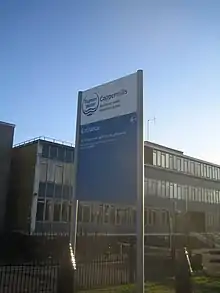Coppermill Stream
The Coppermill Stream is in the London Borough of Waltham Forest at Walthamstow in the Lea Valley. It is a minor tributary of the River Lea and approximately 2 miles (3.2 km) long. The stream is part of a Site of Metropolitan Importance.[1]

Course
Rising close to and fed by water from the Lockwood reservoir the stream flows in a southerly direction under Ferry Lane A503. Before flowing under the Gospel Oak to Barking Line then flowing between the Walthamstow Reservoirs and the East Warwick Reservoir. Before passing next to the Coppermill and close to the Coppermills Water Treatment Works. Flowing parallel with Coppermills Lane and skirting Walthamstow Marshes before passing under the Lea Valley Lines and merging with the River Lee Navigation at the Lee Valley Marina close to Springfield Park.
Coppermill
The stream is named after the Coppermill. The mill was purchased by British Copper Company in 1808. The smelted copper was brought to the mill from Landore, Swansea, Wales via the Thames by barge. The copper ingots were used to produce penny and halfpenny tokens.[2] Production ceased in 1857. Before milling copper the mill can be traced back to the 14th century when corn was ground. In the 1670s the mill was used in the production of gunpowder. Later in 1690 for rolling paper. In 1712 as a leather mill and its next use in the manufacture of linseed oil. The mill was purchased by the East London Waterworks Company in the late 1850s and the mill was modified to drive a water pump to assist in the building of reservoirs on nearby marshland.[3] Today the mill is owned by Thames Water.
Coppermills Water Treatment Works

The Coppermills Water Treatment Works was completed in 1969 [4] and is owned and managed by Thames Water. The works are located at the south end of the Lee Valley Reservoir Chain. In 2005, work was undertaken to link the works to the London ring main via the Northern Extension tunnel. It was completed in 2009 and enables the facility to be a major supplier of water to the London area.[5]
Operations
The Coppermills treatment works is supplied with raw water directly through channels from the East Warwick, Low Maynard, and Walthamstow No. 5 reservoirs. It is also supplied via the ‘Spine Tunnel’ which itself is fed from the Lockwood, King George V, William Girling and Banbury reservoirs.[6]
The first water treatment process at Coppermills works is rapid gravity filtration. There are 24 rectangular open topped tanks containing sand.[7] Water enters the top of the tanks and flows down through the sand layer under gravity. The water residence time in the filters is about 15 minutes.[7] The filters remove particulates and the cleaned water flows from the bottom of the filters. Periodically, every 6 to 24 hours each filter is shut in and clean water is pumped up through the bed together with compressed air to scour the sand and remove material caught during the filtration phase. When the backwashing process is complete the filter is bought back into service.[8]
Ozone gas is then added to the water to oxidise contaminants such as pesticides and organic material.[7] The process of ozonization also kills bacteria. Water then flows to the next stage Slow Sand Filtration.
There are 33 Slow Sand Filter beds at Coppermills water treatment works,[7] which occupy much of the south and east of the site. The sand bed in the filters support a gelatinous biofilm or hypogeal layer in the top few millimetres of the sand.[9] The surface biofilm provides an effective biological treatment. Water passes through the hypogeal layer where contaminants are retained and metabolised by the bacteria, fungi and protozoa.[9] Over several weeks the biofilm becomes thicker and the flow of water reduces. The filter bed is drained and the biofilm layer is scraped off and replaced with fresh sand.[7]
The water then passes through fine 400-micron (400 μm) stainless steel mesh screens.[7] The water is then dosed with chlorine in contact tanks which contain baffles to ensure that chlorine is completely mixed with the water. Chlorine destroys harmful micro-organisms. The water is pumped into the distribution system supplying customers directly or through covered service reservoirs.[7]
Problems occur at treatment works during periods of algal bloom in the reservoirs, which reduce the cycle time of the rapid gravity filters.[6] At Coppermills works this reduces the capacity of the plant from its normal throughput of 560 million litres per day to 380 Ml/d. A new (£46 million) plant was commissioned in 2014 providing 12 rapid gravity filters with a capacity 200 Ml/d.[10]
Ecology
The clean flowing stream is home to many species of coarse fish including the barbel.[11]
References
- Sites of Metropolitan Importance Archived 12 December 2014 at Archive.today Retrieved 12 December 2014
- Token collection at Swansea Museum Archived 27 September 2011 at the Wayback Machine Retrieved 15 December 2007
- The Coppermill Retrieved 14 December 2007
- Lee Valley Park Retrieved 18 March 2011
- Thames Water Retrieved 18 March 2011
- "Algae in raw water storage reservoirs" (PDF). Archived (PDF) from the original on 24 January 2011. Retrieved 22 June 2020.
- Krupinska, Silvia Krupinska (24 January 2018). "Coppermills Water Treatment Works Visit". Retrieved 22 June 2020.
- "Backwashing: a critical factor in water treatment plant performance". tecpro. Retrieved 22 June 2020.
- "Slow sand filtration". SSWM University. Retrieved 22 June 2020.
- "Coppermills water treatment works". esp water. Retrieved 22 June 2020.
- Barbel river records Retrieved 14 December 2007
- Angling information page 12 Archived 21 February 2006 at the Wayback Machine Retrieved 15 December 2007